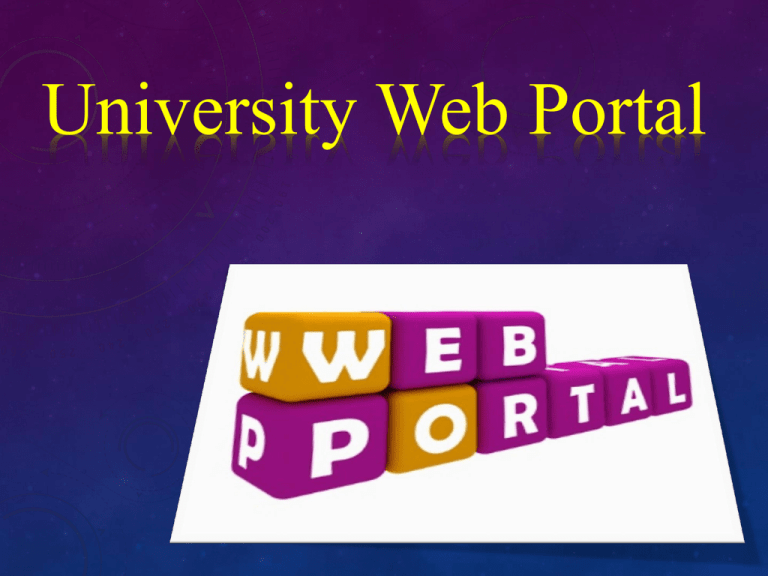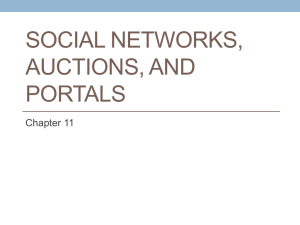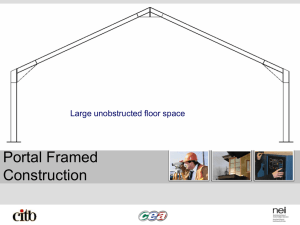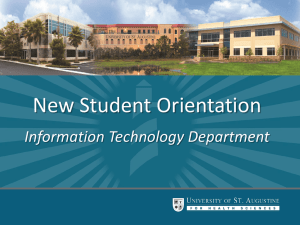Campus Portal Proposal Ellingsburg University
advertisement

University Web Portal WHAT IS A PORTAL? Portal is a term, generally synonymous with gateway, for a World Wide Web site that is or proposes to be a major starting site for users when they get connected to the Web or that users tend to visit as an anchor site. OTHER DEFINITIONS • “An environment that fits specific needs, or stated another way, architecting the environment so people can do what they need to do.” -The University of Washington • “An interactive gateway to resources and services.” -Boston College • “A user-centric Web page that allows users to easily locate all the Web content they commonly use a ‘onestop Web page’.” -Cornell University WHY USE A PORTAL? Encompassing sense of membership Central database into University resources Increased efficiency Publish information campus-wide Single log-in Connection for University Alumni Instantaneous research Access for perspective government officials students, parents, and Web Portal THE DEVELOPMENT PROCESS OF THE COMMUNITY WEB PORTAL PORTALS VS. WEB PRESENCE PORTALS WEB PRESENCE • Single log-in • Multiple Log-In • Can be personalized • Same for all users • Process optimized for users • Process optimized for department • Allow for electronic groups • Allow only for specific users • Easier to use • Rather complex With portals, colleges and universities could see “increased revenue through improved recruitment and retention, reduced recruitment costs, improved customer service, quicker yield conversions, [and] improved customer satisfaction.” BENEFITS Considerable amount of decrease in work load for University Real time data availability of relevant data to Student, Center and University Reduction in number of queries and Issues from Students/Centers Effective status tracking by University Prevention of errors at source Substantial cost reduction Streamlined processes Transparent Student Data Easy for University to communicate to Students/Centers through Message boards and does not require technical expertise MODULES UNIVERSITY ADMINISTRATION PAYROLL PROCESSING FINANCIAL ACCOUNTING ADMISSION EXAMINATION AND EVALUATION MATERIAL PRODUCTION AND DISTRIBUTION STUDENT SUPPORT SERVICES SOFTWARE SECURITY AND DATA MANAGEMENT PORTAL PREDICATES AT A GLANCE WHAT A PORTAL DOES: Enables universal login Handles both structured and unstructured data Facilitates multi-channel consistency Facilitates messaging and notification Automated tuning: pervasive content can be tuned based on personalization, location, browser, etc. Integration to other systems KEY FEATURES OF PORTALS: Security Access different data Transactions Search Publish Content Personal Content WHAT ARE THE MAJOR FUNCTIONS OF PORTALS? search and navigation information integration (content management) personalization notification (push technology) task management and workflow collaboration and groupware integration of applications and business intelligence infrastructure functionality WHAT A PORTAL IS NOT: It is not just a Website (which is usually characterized by static information) It is not just a personalized intranet It is not just a personalized extranet It is not just a personalized front end for business applications It is not just groupware It is not just a personalized knowledge management solution It is not just a sophisticated search engine TYPES OF THE PORTALS (CLASSIFICATION) The portals can be differentiated on the basis of their content and intended users. Horizontal Portals target the entire Internet community. These sites, often referred to as "megaportals", usually contain search engines and provide the ability for user to personalize the page by offering various channels (i.e. access to other information such as regional weather, stock quotes or news updates). Yahoo! and Lycos constitute megaportals. These portals are also gateways to contents and services of other offers. TYPES OF THE PORTALS (CLASSIFICATION) Vertical Portals differ only in their more specific objects and contents from horizontal portals, the technology employed remains the same. The numerous solutions can be divided into 3 major groups that partially overlap: Corporate Portals: provide personalized access to selected information of a specific company. Commerce Portals: support business-to-business and business-to-consumer e-commerce. Pervasive Portals: support access via Pervasive Devices such as PDAs, Particularly this type of vertical portal will have a great stake in the future. TYPES OF THE PORTALS (CLASSIFICATION) ENTERPRISE PORTALS These are portals developed and maintained for use by members of the intranet or the enterprise network. The most common implementation of enterprise portals focus on providing employees with this information on a regularly updated manner along with document management system, availability of applications on demand, online training courses and web casts etc along with communication in the form of emails, messaging, web meetings etc. TYPES OF THE PORTALS (CLASSIFICATION) KNOWLEDGE PORTALS Knowledge portals increase the effectiveness of knowledge workers by providing easy access to information that is necessary or helpful to them in one or more specific roles. Knowledge portals are not mere intranet portals since the former are supposed to provide extra functionality such as collaboration services, sophisticated information discovery services and a knowledge map. TYPES OF THE PORTALS (CLASSIFICATION) CORPORATE PORTALS An corporate portal provides personalized access to an appropriate range of information about a particular company. Corporate portals have become one of the hottest new technologies of the Internet. Initially called intranet portals - corporate portals existing for the benefit of the company’s own employees, this set of technologies has developed to assist and provide access to a company’s business partners (suppliers, customers) as well. As opposed to public web portals, corporate portals aim at providing a virtual workplace for each individual using them - executives, employees, suppliers, customers, third-party service providers. Rather than offering access to consumer goods, services, and information, corporate portals are designed to give each individual using them access to all of the information, business applications, and services needed to perform their jobs. A company’s public Website itself is not automatically a corporate portal. It can become one if the Website provides personalization and navigation functionality, as many are beginning to do. TYPES OF THE PORTALS (CLASSIFICATION) MARKET SPACE PORTALS Market space portals exist to support the business-to-business and business-to-customer ecommerce, software support for e-commerce transactions and ability to find and access rich information about the products on sale also, ability to participate in discussion groups with other vendors and/or buyers. EXEMPLARY PORTAL SITES MSN GOOGLE AOL YAHOO AMAZON SAMPLE UNIVERSITY WEB PORTAL SAMPLE 2 UNIVERSITY WEB PORTAL PORTAL ORGANIZATION • Specific for each audience • Perspective Students, Current Students, Faculty, Staff, Alumni, Parents, Supporters of Athletic Programs, Visitors • Side Directory • Side bar of important links geared towards the above audience • Tech Support • Online access to trouble shooting guide and FAQs • Personalization • Allow users to personalize their portal to include particular links for their specific needs COMMUNICATION TOOLS • Communication tools allow users to interact with each other, sharing information in a safe environment. • Examples: • E-mail • Portal based e-mail systems allow users to communicate within specific groups (e.g. residence halls, class, administrative offices, or clubs) • Chat rooms • Portal based chat rooms enhance student learning experiences in safe and monitored environments • Announcements • Portal based systems can reduce supply costs by providing an electronic way to advertise PLANNING TEAM The following offices or groups will be represented: Academic Departments Faculty Senate Admissions/Orientation Health Center Alumni Affairs Residence Life Athletics Research/Assessment Bookstore Registrar Board of Trustees Student Government Bursar Student Union Communications Technology Library TRANSLOCATION SERVICES • Translocation services allow for “paper-free” services, faster and more complete customer service, and easier access for users. • Examples: • Admissions/Orientation • On-line applications and Financial aid applications • Academic • Online registration, grade reports, and transcripts • Financial • Pay bills, apply for student loans, financial aid application, and debit system for student ID • Extra-Curricular • Sign up for clubs, committees, and organizations; online housing selection; online applications for job opportunities HOW TO GET STARTED • Focus Groups • Utilize focus groups of students, faculty, staff and alumni to see what their Web based needs are. • Research Peer Institutions • Look at other institutions of similar size in the region and see what they are doing on their websites. • Review Literature • General resources are available for more information on this topic. GOOD “PRACTICE SITES” • University of Washington • http://myuw.washington.edu • University of California Los Angeles • http://my.ucla.edu • Boston College • http://www.ja~sig.org • Louisiana State University • http://paws.lsu/edu • University of Minnesota • http://onestop.umn.edu









